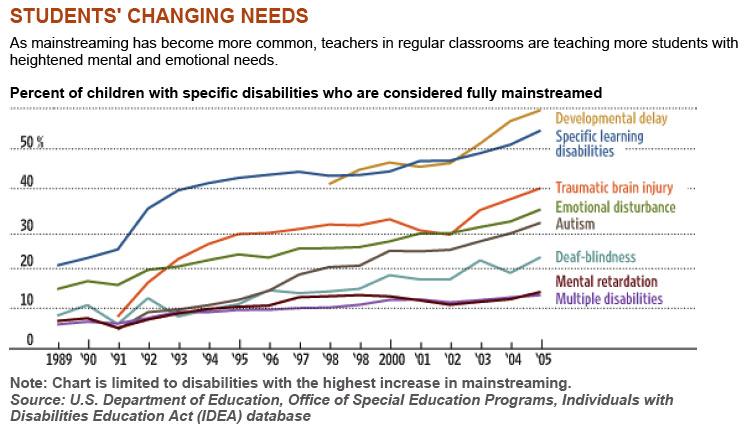The recent Wall Street Journal article “Mainstreaming Trend Tests Classroom Goals” by John Hechinger included some useful charts along with a look at Key US Special Education Legislation:
- 1966—Elementary and Secondary Education Act (Amendments): Creates Bureau of Education of the Handicapped. Establishes federal grants to help educate special-needs students with disabilities in local schools rather than state institutions. At left, President Lyndon Johnson with the first lady at the signing.
- 1975—Education for All Handicapped Children Act: Requires school districts receiving federal funds to provide a free and appropriate public education in the least restrictive environment to special-needs children.
Mandates creation of an individualized education program (IEP) for such students. Establishes procedures for parents to challenge related decisions about their children.
- 1990—Individuals with Disabilities Education Act: Revised and renamed version of 1975 law adds autism and traumatic brain injury to categories of special education. Calls for transition services to help older students prepare for post-secondary education, employment and independent living.
- 1997—IDEA reauthorization: Expands school administrators authority to discipline special education students in certain situations to include removal to alternative education settings for up to 45 days. Prohibits cutting off educational services to special-education students who are expelled.
- 2002—No Child Left Behind Act: Requires all students to take annual assessment tests although states can make reasonable accommodations for those with disabilities. Special-education teachers must be “highly qualified” in core subjects they teach. At left, President Bush talking up the law at an Arkansas school.
- 2002—No Child Left Behind Act: Requires all students to take annual assessment tests although states can make reasonable accommodations for those with disabilities. Special-education teachers must be “highly qualified” in core subjects they teach. At left, President Bush talking up the law at an Arkansas school.
- 2004—IDEA reauthorization: Requires all special education teachers to hold at least a bachelors degree and full state certification. Places a two-year statute of limitations on parents ability file a complaint or request a hearing regarding childs treatment.
Requires review of relevant records by parents and school officials within 10 days of a childs change of placement for disciplinary reasons.






And the point of this piece is what, that mainstreaming special ed students is a minor source of teacher dissatisfaction? Interesting how they highlight mainstreaming, as opposed to “too little support from parents”- that says to me: more propoganda. How about next time, they survey teachers about their rewarding experiences helping mainstreamed, disabled children succeed? Oh yeah, then the Wall Street Journal couldn’t sell as many papers…we’ll leave those success and satisfaction pieces for the NY Times.
There is no question that the Federal Laws have created a trend to mainstream special ed students. The MMSD, over the past decade, has done an admirable job with inclusion. The MMSD, however, IS struggling with keeping up their former levels of service. This is strictly due to budget cuts, and it’s no different than any other aspect of the MMSD- everyone is getting less and less in terms of services/support.
I found it interesting that they determined that because a student with special needs was “mainstreamed” they were not receiving the same amount of special education service! I can personally attest to the richness of a “push-in” special education model, where the students IEP and individual needs are met in the general education classroom!